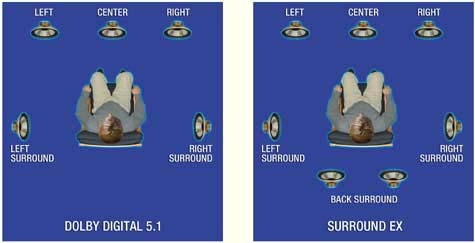Hercules Fortissimo III 7.1 and Digifire 7.1
Dolby Digital
In 1965, an American physicist and engineer called Ray Dolby founded the Dolby Laboratories in London. His idea was to develop noise reduction systems to improve sound quality for professionals and general public alike. The name of Dolby is now known throughout the world and the surround sound standards he created are used both in movie theaters and the private home. First of all a description of the two Dolby Digital ancestors:
- Dolby Surround: this has three channels, two for the front and one for the rear with a bandwidth of 100 Hz to 7 kHz.
- Dolby Pro Logic: this is an enhancement of Dolby Surround with 4 channels, including a center one and two elements sharing a channel for the rear sound.
As for Dolby Digital 5.1, also called AC-3 (for Audio Code-3), this has 6 channels - two front, two rear, one center and one for the subwoofer. When a movie is shot, the sound is generally recorded with at least five microphones (a boom for the voices and four mikes for background sound effects). Unlike Dolby Surround and Pro Logic, the bandwidth here ranges from 20 Hz to 20 kHz. The term AC-3 refers to a coding technology which eliminates sound data the user cannot hear and produces a Dolby Digital sound track coded on six channels. An absolute prerequisite for Dolby Digital sound is a decoder, such as the one on the Creative Labs Extigy, or else a sound card like Fortissimo III.
Dolby Digital uses a fixed sound compression method of about 1:12. This means that however much sound there is to encode, compression will always be the same, so we have a compression algorithm with a constant output. The practical side of this is in the disk space, but the downside is that sound quality decreases as its volume increases. But to set against this is that the less space used on a DVD, the more space is available for different languages or bonuses, and this can compensate for a loss of quality. In general, AC-3 sound is coded in 18 bits, so the standard output of an AC-3 flow is 384 kbps (6 channels x 18 x 48 kHz). On restitution, the Dolby Digital decoder transmits with a delay of one millisecond on the front channels because the listening position is usually closer to the rear speakers than the front or center ones. This optimizes simultaneous sound reception. With some decoders you can adjust this delay to give the best listening configuration.
The main advantage of the Dolby Digital standard is that it is the digital audio surround standard for DVD. In the rules defining the DVD standard, no other kind of digital sound track can be inserted on a DVD unless there is also a Dolby Digital sound track. So you'll never find, say, a DTS sound track on its own, and most DVDs only have the one digital sound track, the Dolby. This leads to the second advantage of the standard - it is virtually universal. The first movie with a Dolby Digital 5.1 sound track was "Batman returns" in 1992. Since then, practically all DVDs have extended the standard.
Dolby Digital EX is an enhanced version of Dolby Digital 5.1 in that it has a support for an extra surround speaker or two behind the listening position. This means you can put your side speakers in the right position and gain in sound effects and immersion from the back. Remember though that Dolby Digital EX is not a "true" 6.1 or 7.1 sound standard because the surround channel is matrix encoded from the conventional 5.1 surround speakers. The sound is recorded as in Dolby Digital and the sixth channel is added when the initial encoding is done. The sound engineers view the film and decide which sounds should be moved to the rear, so the EX is definite progress. As for the argument over whether 6.1 or 7.1 is better, this is rather pointless. In 6.1, the rear center speaker produces mono sound. In 7.1 the two rear center speakers produce the same mono sound. The advantage of Fortissimo III 7.1 and Digifire 7.1 is that you can have either 6.1 or 7.1 depending on whether you want more or less. The choice between the two modes is a purely technical one: if you have a large room with lots of widely-spaced listening positions, the 7.1 is best, otherwise the 6.1 is perfectly adequate.
Get Tom's Hardware's best news and in-depth reviews, straight to your inbox.
Current page: Dolby Digital
Prev Page The 5.1, 6.1 And 7.1: A Speaker Multiplication Table Next Page DTS
